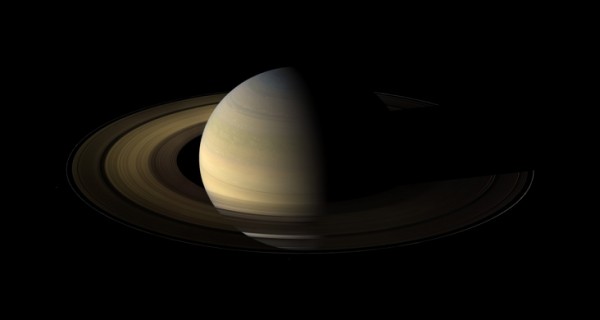How Did Saturn's Days Become Shorter?
| Ana Verayo | | Mar 27, 2015 09:20 AM EDT |
(Photo : NASA) Cassini's wide angle camera shows Saturn, its rings, and a few of its moons.
Astronomers are saying the rate of Saturn's rotation that's been quoted in textbooks apparently needs to be rewritten.
They concluded that a Saturnian day, which equals a period of one rotation, is actually six minutes shorter than the estimate in textbooks.
Six minutes may not seem like such a big deal but this will cause confusion among scientists and change how they think about how the winds on Saturn move, according to planetary scientist Ravit Helled from Tel Aviv University in Israel.
Like Us on Facebook
Scientists can't pinpoint the exact rotation period of Saturn, however. When the Voyager spacecraft flew past the gas planet during the 1980s, it recorded 10 hours and 39 minutes, but the Cassini spacecraft that orbited the planet in 2004 measured 10 hours and 47 minutes.
Helled says ever since different numbers were measured by different NASA probes, Saturn's exact rotation period hasn't been determined. In the last few years, however, there have been theoretical attempts to pinpoint an answer.
Helled's team used Saturn's magnetic field to extract the spin rate of the gas planet. The result they got was 10 hours 32 minutes and 45 seconds, which is six minutes faster than Voyager's estimate.
Planetary scientists believe those six minutes make a big difference since it means that Saturn's equator from the level of its atmosphere is now spinning 250 miles faster than what Voyager predicted. This will affect wind speeds in the atmosphere.
The Voyager estimate suggests most winds are blowing in just one direction, but the new result is evidence in itself that around half the winds are blowing west and the other half is blowing east, which could make more sense, says Andrew Ingersoll from the California Institute of Technology.
This new measurement can certainly help scientists gain more insights about Saturn's atmosphere and winds and even determine how heavy elements such as water and rocks are formed in its interior just by figuring out the planet's rotation.
This study can be read in the journal, Nature.
TagsHow Did Saturn's Days Become Shorter?, Saturn, how long is one day on saturn, saturn spin days shorter
©2015 Chinatopix All rights reserved. Do not reproduce without permission
EDITOR'S PICKS
-

Did the Trump administration just announce plans for a trade war with ‘hostile’ China and Russia?
-

US Senate passes Taiwan travel bill slammed by China
-

As Yan Sihong’s family grieves, here are other Chinese students who went missing abroad. Some have never been found
-

Beijing blasts Western critics who ‘smear China’ with the term sharp power
-

China Envoy Seeks to Defuse Tensions With U.S. as a Trade War Brews
-

Singapore's Deputy PM Provides Bitcoin Vote of Confidence Amid China's Blanket Bans
-

China warns investors over risks in overseas virtual currency trading
-

Chinese government most trustworthy: survey
-

Kashima Antlers On Course For Back-To-Back Titles
MOST POPULAR
LATEST NEWS
Zhou Yongkang: China's Former Security Chief Sentenced to Life in Prison

China's former Chief of the Ministry of Public Security, Zhou Yongkang, has been given a life sentence after he was found guilty of abusing his office, bribery and deliberately ... Full Article
TRENDING STORY

China Pork Prices Expected to Stabilize As The Supplies Recover

Elephone P9000 Smartphone is now on Sale on Amazon India

There's a Big Chance Cliffhangers Won't Still Be Resolved When Grey's Anatomy Season 13 Returns

Supreme Court Ruled on Samsung vs Apple Dispute for Patent Infringement

Microsoft Surface Pro 5 Rumors and Release Date: What is the Latest?










